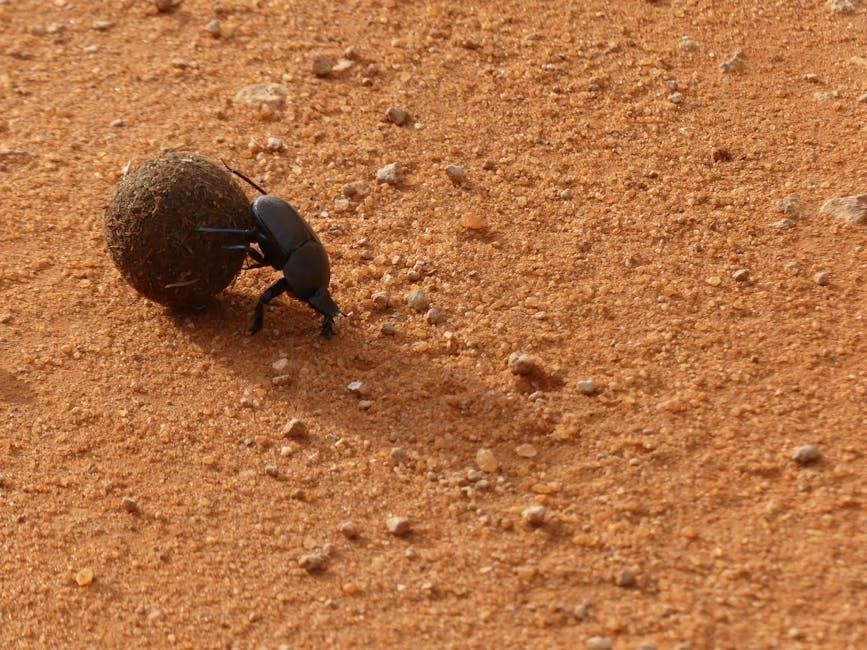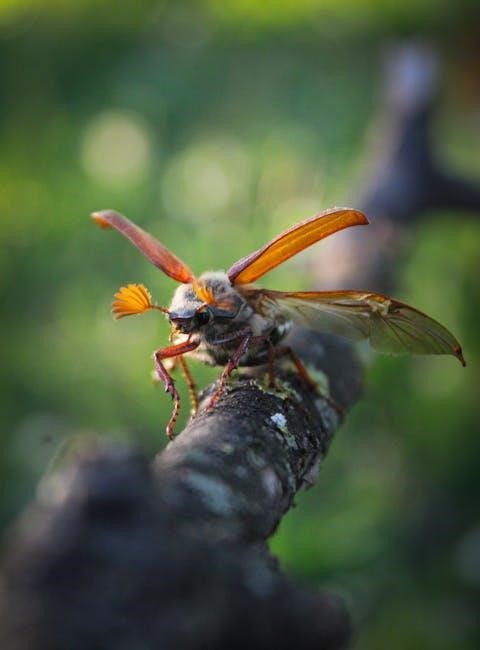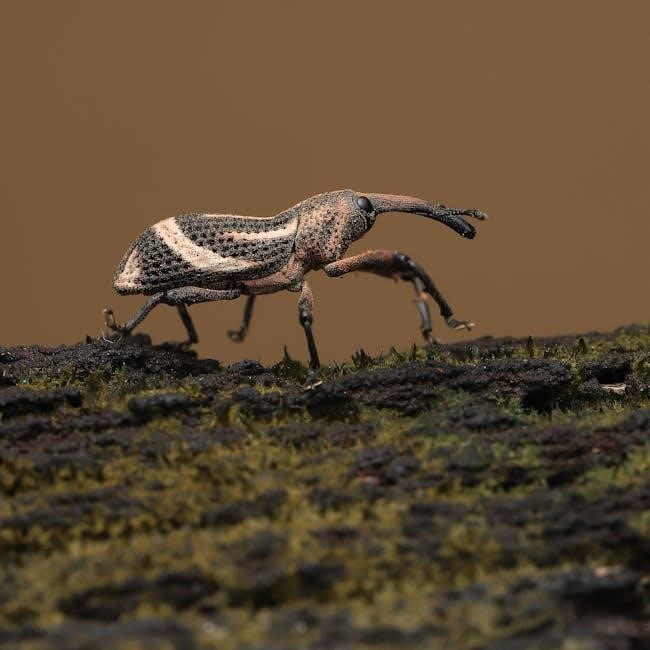The Scarab of Death, a symbol rooted in ancient Egyptian culture, represents transformation and resurrection. Its historical significance is tied to funerary practices and divine mythology, making it a profound artifact in both religious and historical contexts.
1.1 Historical Significance of the Scarab Beetle in Ancient Cultures
The scarab beetle holds profound historical significance in ancient cultures, particularly in Egypt, where it symbolized rebirth and transformation. Revered for its life cycle, the beetle was associated with the sun god Ra, embodying regeneration and cosmic order. In Egyptian society, scarabs were used as jewelry, amulets, and seals, often placed in tombs to ensure the deceased’s safe passage to the afterlife. Beyond Egypt, scarabs were valued in Mesopotamia and the Mediterranean for their symbolic and spiritual meanings. Their widespread use underscores their importance as cultural and religious icons, reflecting ancient societies’ deep connection to nature and the mysteries of life and death.
1.2 The Concept of Death in Ancient Egyptian Symbolism
In Ancient Egyptian symbolism, death was not an end but a transformation, reflecting the belief in an afterlife. The scarab beetle, with its cyclical life cycle, became a powerful symbol of rebirth. Death was seen as a transition to the spiritual realm, where judgment by Osiris awaited. Symbols like the ankh (key of life) and the was sceptre emphasized eternal existence. The scarab, rolling the sun, mirrored the soul’s journey through the afterlife. This duality of death and rebirth was central to Egyptian spirituality, with the scarab embodying hope for eternal renewal and divine connection.
1.3 The Role of the Scarab in Funerary Practices
The scarab played a pivotal role in ancient Egyptian funerary practices, serving as a protective and magical object. Often placed in tombs, scarabs were believed to ensure the deceased could perform essential functions in the afterlife. Associated with spells from the Book of the Dead, they were sometimes placed over the heart to guarantee its weighing during judgment. Made from materials like green stone symbolizing rebirth, scarabs were also used to invoke divine protection. This practice underscored the scarab’s dual role as a symbol of resurrection and a tool for guiding the soul through the afterlife, reflecting Egypt’s deep reverence for cyclical renewal.

The Scarab Beetle in Ancient Egyptian Religion
The scarab beetle was a sacred symbol in ancient Egyptian religion, embodying rebirth and regeneration. It was closely associated with the sun god Ra and the cyclical nature of life.
2.1 The Scarab as a Symbol of Rebirth and Resurrection
The scarab beetle symbolized rebirth and resurrection in ancient Egyptian religion. Its life cycle, where it rolls dung into balls and lays eggs, mirrored the sun’s journey, signifying regeneration. The scarab’s transformation from larvae to adult was seen as a metaphor for the soul’s journey to the afterlife. In funerary practices, scarabs were placed over the heart to ensure the deceased’s rebirth. This symbolism tied the beetle to the sun god Ra, reinforcing its role in cosmic renewal. The scarab’s imagery in tombs and rituals underscored its divine connection, making it a powerful emblem of eternal life and spiritual resurrection.
2.2 The Connection Between the Scarab and the Sun God Ra
The scarab beetle was deeply connected to the sun god Ra, embodying his journey across the sky. The beetle’s habit of rolling dung into balls mirrored the sun’s movement, symbolizing creation and renewal. As a manifestation of Ra, the scarab represented divine energy and cosmic order. In funerary rites, scarabs were placed over the heart to ensure the deceased’s rebirth, aligning with Ra’s role in resurrecting the sun each dawn. This sacred connection elevated the scarab as a symbol of eternal life, linking it to Ra’s power and the cyclical nature of existence, reinforcing its central role in Egyptian religious and funerary traditions.
2.3 The Use of Scarabs in Ancient Egyptian Magic and Rituals
Scarabs played a pivotal role in ancient Egyptian magic and rituals, serving as potent symbols of protection, transformation, and regeneration. They were often inscribed with spells from the Book of the Dead, ensuring the deceased could navigate the afterlife. In rituals, scarabs were used to invoke divine powers, particularly those associated with Ra, to guarantee rebirth and eternal life. Their magical properties were believed to ward off evil spirits and bring vitality. As amulets, scarabs were placed in tombs to safeguard the deceased, while in spells, they were thought to activate the transformative forces necessary for resurrection, making them indispensable in both religious and funerary practices.

The Scarab of Death in Literature and Media
The scarab of death appears in literature as a motif of mystery and transformation, notably in Edgar Allan Poe’s works, symbolizing death and rebirth themes in modern horror and RPGs.
3.1 The Scarab as a Motif in Edgar Allan Poe’s Works
Edgar Allan Poe often incorporated the scarab as a motif, symbolizing death and transformation. In “Some Words with a Mummy,” the scarab represents immortality and the afterlife, reflecting Poe’s fascination with mortality and the supernatural. The scarab’s presence in his works often signifies psychological turmoil and the mysteries of death, aligning with Poe’s themes of loss and the unknown. Its use in stories like “The Gold-Bug” further highlights its role as a cryptic symbol, tying into the darker aspects of human curiosity and the pursuit of forbidden knowledge. This motif underscores Poe’s ability to weave ancient symbols into modern narratives of mystery and dread;
3.2 The Scarab in Modern Horror Literature and Film
In modern horror, the scarab beetle is often depicted as an eerie and ominous symbol, evoking ancient curses and death. Films like The Mummy feature scarabs as harbingers of doom, crawling from tombs to infest the living. In literature, authors use scarabs to signify corruption and supernatural transformation, as seen in works by Clive Barker. The beetle’s association with decay and resurrection amplifies horror elements, creating a sense of dread. This timeless symbol continues to captivate audiences, linking ancient myths with contemporary fear, making it a staple in the horror genre for its unsettling and memorable imagery.
3.3 The Scarab as a Symbol in Role-Playing Games (RPGs)
The scarab beetle emerges as a compelling symbol in RPGs, often linked to rebirth and transformation. In Dungeons & Dragons, it may serve as a quest item or a companion, guiding players through ancient tombs. Its presence in Eldamon Battlezoo highlights its role in puzzles and character abilities, reflecting its mythological significance. Different RPGs interpret the scarab uniquely, with some emphasizing resurrection mechanics and others focusing on curse-breaking quests. Visually, the scarab’s design varies, blending cultural influences with the game’s art style. This versatility makes the scarab a dynamic and enduring element in RPG narratives and game mechanics, enriching both storytelling and gameplay experiences.

Archaeological Discoveries Related to the Scarab
Archaeologists have uncovered scarabs in ancient tombs, revealing their significance in funerary rites and trade. These artifacts provide insights into the cultural and economic practices of past civilizations.
4.1 Notable Scarab Beetles Found in Ancient Tombs
Notable scarab beetles discovered in ancient tombs highlight their symbolic and funerary significance. Many scarabs, crafted from materials like lapis lazuli and gold, were found in pharaonic burial sites, serving as amulets or jewelry. The most famous example is the golden scarab from Tutankhamun’s tomb, which was placed over his heart to ensure rebirth. Some scarabs were inscribed with spells from the Book of the Dead, reinforcing their role in guiding the deceased through the afterlife. These artifacts underscore the scarab’s importance in ancient Egyptian funerary practices and its enduring connection to themes of resurrection and eternal life.
4.2 The Scarab’s Role in Ancient Trade and Economy
The scarab beetle played a significant role in ancient trade and economy, often serving as a seal or symbol of authenticity in commercial transactions. Scarabs were used to mark goods, ensuring their origin and quality, and were highly valued for their craftsmanship. Made from materials like lapis lazuli and carnelian, they were traded extensively across the Mediterranean and Near East. Their production and distribution supported a thriving industry, employing artisans and merchants. Additionally, scarabs were used as currency or offerings in religious contexts, further embedding them in the economic fabric of ancient societies. This dual role highlights their cultural and monetary significance.
4.3 The Significance of Scarabs in Royal Burials
Scarabs held profound significance in royal burials, often placed on the chest of the deceased to symbolize protection and rebirth. In elite tombs, scarabs were inscribed with spells from the Book of the Dead, ensuring the heart did not betray the deceased during judgment. These artifacts were crafted from precious materials like lapis lazuli and gold, underscoring their sacred value. Their presence in royal burials highlighted the elite’s desire to emulate the gods and secure a successful transition to the afterlife. Scarabs in royal contexts also reinforced the pharaoh’s divine connection, solidifying their legacy and spiritual journey.
The Scarab in Modern Culture
The scarab’s allure extends into modern culture, inspiring fashion, contemporary art, and design. Its digital presence thrives in media, advertising, and educational platforms, symbolizing rebirth and transformation.
5.1 The Scarab as a Fashion and Jewelry Icon
The scarab beetle has become a prominent symbol in fashion and jewelry, inspiring high-end designers with its ancient allure. Its imagery is often incorporated into intricate designs, symbolizing rebirth and transformation. Contemporary jewelry pieces frequently feature scarab motifs, crafted in gold, silver, and precious stones, drawing on its historical significance. Fashion brands also embrace the scarab as a cultural icon, blending Egyptian heritage with modern aesthetics. Its appeal spans across luxury and streetwear, making it a versatile and enduring symbol in the fashion world. The scarab’s mystique continues to captivate, bridging the gap between antiquity and contemporary style.
5.2 The Scarab in Contemporary Art and Design
Contemporary artists and designers draw inspiration from the scarab’s symbolic richness, integrating it into diverse mediums. From sculptures to digital installations, the scarab’s form and meaning are reinterpreted through modern techniques. Designers use the scarab’s motifs in textiles, ceramics, and architecture, blending ancient themes with innovative styles. Its association with rebirth and transformation resonates in abstract art, where it represents renewal and cycles of life. Digital art platforms also feature the scarab, creating immersive experiences that highlight its cultural significance. This fusion of tradition and modernity ensures the scarab remains a dynamic and evolving symbol in contemporary creative expressions and cultural narratives.
5.3 The Scarab as a Cultural Symbol in Advertising and Media
The scarab’s universal appeal makes it a popular motif in advertising and media, symbolizing rebirth and renewal. Brands incorporate scarab imagery to convey themes of transformation and resilience, appealing to audiences seeking meaningful connections. In media, the scarab often appears in historical dramas and documentaries, serving as a visual shorthand for ancient Egyptian culture. Its presence in horror genres links it to mystery and the supernatural, enhancing storytelling depth. Advertisers leverage its symbolic richness to evoke emotions and trust, while media productions use it to bridge cultural gaps, ensuring the scarab remains a potent and recognizable symbol across global audiences and industries. Its versatility endures.

The Scarab of Death in Historical Mysteries
The Scarab of Death is often linked to unsolved historical crimes, where its presence serves as a mysterious clue, tying ancient symbolism to modern investigative puzzles and intrigue.
6.1 The Scarab Murder Case: Historical Context
The Scarab Murder Case, infamous in historical mysteries, revolves around the brutal murder of philanthropist Benjamin H. Kyle; The scarab beetle found at the crime scene symbolized ancient Egyptian themes, suggesting a ritualistic element. This case became notorious for its blend of modern crime and ancient symbolism, captivating detectives and historians alike. The scarab’s presence hinted at a deeper, cultural motive, making it a unique and intriguing puzzle in the annals of criminal history.
6.2 The Role of the Scarab in Solving Historical Crimes
The scarab’s symbolic significance played a pivotal role in unraveling historical crimes, particularly in cases involving ritualistic elements. In the Scarab Murder Case, the beetle’s presence at the crime scene provided a critical clue, linking the crime to ancient Egyptian motifs. Detectives leveraged the scarab’s cultural and religious meanings to trace motives and identify suspects. Its role in solving such crimes highlights the intersection of symbolism and forensic investigation, demonstrating how ancient artifacts can hold modern relevance in legal contexts.
6.3 The Scarab as a Clue in Detective Novels
The scarab has become a recurring symbolic clue in detective novels, often used to unravel mysteries tied to ancient Egyptian themes. Authors like Edgar Allan Poe and Agatha Christie incorporated the scarab to signify hidden truths or motives. In Poe’s works, the scarab appeared as an enigmatic element, while Christie used it to hint at Ritualistic murders. Modern detective novels continue this tradition, employing the scarab as a cryptic object that challenges protagonists to decode its significance. Its presence often bridges ancient mythology with contemporary crimes, making it a compelling and mysterious clue for investigators and readers alike.

The Scarab in Educational and Academic Contexts
The scarab is studied in Egyptology for its cultural significance, used in educational materials for interactive learning, and explored in academic research for interdisciplinary insights;
7.1 The Study of Scarabs in Egyptology
In Egyptology, scarabs are meticulously studied for their role in ancient Egyptian culture. These beetles symbolize rebirth and regeneration, often associated with the sun god Ra. Archaeologists analyze scarabs found in tombs and burial sites to understand funerary practices and religious beliefs. The intricate designs and inscriptions on scarabs provide valuable insights into the social and religious dynamics of the time. Additionally, scarabs were used as amulets, believed to offer protection and ensure the deceased a successful transition into the afterlife. Their study is integral to reconstructing Egypt’s historical and cultural tapestry, offering a window into the civilization’s spiritual and daily life.
7.2 The Use of Scarabs in Educational Materials
Scarabs are frequently incorporated into educational materials to teach students about ancient Egyptian culture, religion, and funerary practices. These materials often feature illustrations and descriptions of scarabs, highlighting their symbolic meanings and historical significance. In e-learning platforms and textbooks, scarabs are used to explain concepts like rebirth, resurrection, and the afterlife.Interactive activities, such as virtual excavations or artifact analysis, engage students with scarab-related content. This approach helps learners visualize and understand the role of scarabs in ancient society, making history more accessible and engaging for diverse audiences.
7.3 The Scarab as a Subject in Academic Research
The scarab is a significant subject in academic research, particularly within Egyptology and archaeology. Scholars study its role in ancient Egyptian symbolism, its evolution over time, and its presence in tombs and artifacts. Research often focuses on the scarab’s association with rebirth, resurrection, and the afterlife, as well as its connection to the sun god Ra. Advanced imaging technologies and dating methods have provided deeper insights into the materials and craftsmanship of scarabs. Academic papers frequently analyze scarabs to understand their cultural, religious, and historical contexts, making them a vital part of ongoing scholarly exploration and discovery in these fields.
The Scarab of Death in Digital Media
The Scarab of Death is featured in digital media, including video games and e-learning platforms, symbolizing transformation and mystery. Its digital presence enhances interactive storytelling and educational content.
8.1 The Scarab in Video Games and Virtual Worlds
The Scarab of Death is a popular motif in video games, often symbolizing mystery, transformation, and ancient lore. In RPGs, it appears as a clue or artifact, guiding players through puzzles and mysteries. Virtual worlds incorporate scarabs to enhance immersive storytelling, linking them to historical or mythological themes. Games like Eldamon feature scarabs as magical elements, while others use them in puzzles to unlock hidden content. This digital presence highlights the scarab’s enduring appeal, blending its historical significance with modern interactive media to create engaging experiences for players and learners alike.
8.2 The Scarab as a Digital Symbol in Online Communities
The Scarab of Death has become a symbolic figure in online communities, often representing mystery and transformation. In gaming forums, it’s used to hint at hidden content or puzzles. Social media groups and e-learning platforms, like Think Digital Academy, incorporate scarabs to engage users with historical themes. Online advertisers leverage its ancient allure to capture attention, while in virtual classrooms, it serves as a visual aid for lessons on Egyptology. This digital presence highlights the scarab’s enduring appeal, blending its historical significance with modern online interactions to foster curiosity and learning.
Its versatility makes it a popular motif across diverse digital spaces.
8.3 The Representation of the Scarab in E-Learning Platforms
In e-learning environments, the Scarab of Death is often used to enhance educational content, particularly in history and culture courses. Platforms like Think Digital Academy incorporate scarab imagery in multimedia presentations to engage students. Interactive modules feature the scarab to teach its historical and symbolic significance. Virtual classrooms utilize 3D animations of scarabs to illustrate ancient Egyptian funerary practices. This approach makes complex topics more accessible and visually appealing. The scarab’s representation in e-learning fosters a deeper understanding of its cultural and historical importance, blending tradition with modern educational tools to create an immersive learning experience.
Its digital presence enriches curriculum delivery worldwide.






